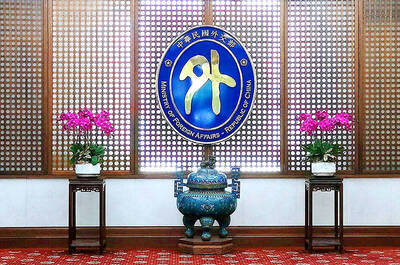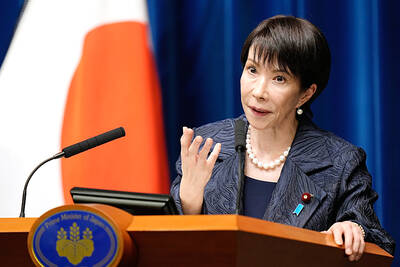Puyuma people from Taitung County’s Katatipul Community yesterday traveled to Taipei to protest a solar power installation project planned on their land, demanding that the government terminate the project unless local Aborigines consent.
Dressed in traditional costumes, nearly 20 Puyuma protested in front of the Executive Yuan compound, holding Chinese-language banners that read: “The land is my mother, not your cash dispenser” and “defend sovereignty and revoke the project.”
The county government in January last year announced bidding for the development project, which is to cover 226 hectares and estimated to be worth NT$8 billion (US$259.6 million), said Chen Cheng-tsung (陳政宗), convener of the group.
Puyuma ancestors settled in the area in the 16th century, but they were not involved in the project’s planning process, as required by Article 21 of the Indigenous Peoples Basic Law (原住民族基本法), Chen said.
The development area is in the community’s domain and partly overlaps the Jhihben Wetlands (知本溼地), community member Lu Hung-wen (呂宏文) said.
The community does not oppose solar power development, but the government should consult local Aborigines’ opinions before opening the area for development, Lu said.
They protested yesterday instead of earlier because it took community members time to understand the project and the law, Lu said.
While the county government had convened meetings to explain the project, they were mostly one-way policy promotion events, Environmental Rights Foundation chief executive Tu Yu-wen (涂又文) said, urging the central government to push local officials to improve communication with Aborigines as required by law.
Also at the protest were nuclear power proponents Huang Shih-hsiu (黃士修) and Liao Yen-peng (廖彥朋), who said that the government should not sacrifice Aboriginal rights and wetland ecology to promote its “nuclear-free homeland.”
However, community members rejected their support.
Most community members do not know the advocates of nuclear power and were baffled by their uninvited appearance, Lu said, adding that Huang and Liao should not co-opt the demands of Aborigines.
The protest is not about supporting or opposing green energy development, but about consulting Aborigines’ opinions before exploiting their land, Indigenous Youth Front member Savungaz Valincinan said.
The Executive Yuan received the Puyuma appeal and said it would relay the information to the agency in charge.

The Ministry of Foreign Affairs (MOFA) yesterday voiced dissatisfaction with the Comprehensive and Progressive Agreement for Trans- Pacific Partnership (CPTPP), whose latest meeting, concluded earlier the same day, appeared not to address the country’s application. In a statement, MOFA said the CPTPP commission had "once again failed to fairly process Taiwan’s application," attributing the inaction to the bloc’s "succumbing to political pressure," without elaborating. Taiwan submitted its CPTPP application under the name "Separate Customs Territory of Taiwan, Penghu, Kinmen and Matsu" on Sept. 22, 2021 -- less than a week after China

THE GOOD WORD: More than 100 colleges on both sides of the Pacific will work together to bring students to Taiwan so they can learn Mandarin where it is spoken A total of 102 universities from Taiwan and the US are collaborating in a push to promote Taiwan as the first-choice place to learn Mandarin, with seven Mandarin learning centers stood up in the US to train and support teachers, the Foundation for International Cooperation in Higher Education of Taiwan (FICHET) said. At the annual convention of the American Council on the Teaching of Foreign Languages held over the weekend in New Orleans, Louisiana, a Taiwan Pavilion was jointly run by 17 representative teams from the FICHET, the Overseas Community Affairs Council, the Steering Committee for the Test of Proficiency-Huayu, the

A home-style restaurant opened by a Taiwanese woman in Quezon City in Metro Manila has been featured in the first-ever Michelin Guide honoring exceptional restaurants in the Philippines. The restaurant, Fong Wei Wu (豐味屋), was one of 74 eateries to receive a “Michelin Selected” honor in the guide, while one restaurant received two Michelin stars, eight received one star and 25 were awarded a “Bib Gourmand.” The guide, which was limited to restaurants in Metro Manila and Cebu, was published on Oct. 30. In an interview, Feng Wei Wu’s owner and chef, Linda, said that as a restaurateur in her 60s, receiving an

MORE RETALIATION: China would adopt a long-term pressure strategy to prevent other countries or future prime ministers following in Sanae Takaichi’s steps, an academic said Taiwan should maintain communications with Japan, as Japanese Prime Minister Sanae Takaichi is to lead a revision of security documents, Taiwanese academics said yesterday. Tensions have risen between Japan and China over remarks by Takaichi earlier this month that the use of force against Taiwan would constitute a “survival-threatening situation” for Japan. Prospect Foundation president Lai I-chung (賴怡忠) yesterday said Takaichi’s stance regarding Taiwan is the same as past Japanese prime ministers, but her position is clearer than that of her predecessors Fumio Kishida and Shigeru Ishiba. Although Japan views a “Taiwan contingency” as a “survival-threatening situation,” which would allow its military to